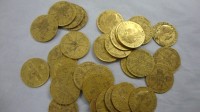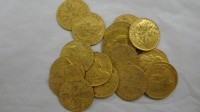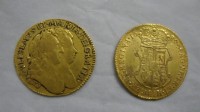 At noon on Monday, January 14th, construction workers renovating Cooney’s Bar in the South Tipperary town of Carrick-on-Suir unearthed 81 gold coins from the 17th century. The building crew was digging a hole in front of the pub’s bar area to prep the area before pouring a new concrete pad when Shane Murray found the coins lying on their sides, back to front like they were in one of those paper tubes you get at the bank to organize your penny jar. Whatever was once holding them together has decayed but the shape remains. The space where they were stashed was a recess — possibly an old door opening or a fireplace — opposite where the pub’s front counter once stood.
At noon on Monday, January 14th, construction workers renovating Cooney’s Bar in the South Tipperary town of Carrick-on-Suir unearthed 81 gold coins from the 17th century. The building crew was digging a hole in front of the pub’s bar area to prep the area before pouring a new concrete pad when Shane Murray found the coins lying on their sides, back to front like they were in one of those paper tubes you get at the bank to organize your penny jar. Whatever was once holding them together has decayed but the shape remains. The space where they were stashed was a recess — possibly an old door opening or a fireplace — opposite where the pub’s front counter once stood.
Murray showed them to his boss, contractor Shane Comerford, and Comerford threw them on the ground thinking they were fakes or tokens or some other kind of insignificant geegaw. Murray knew they were for reals gold, though, so he scooped them up. He and his crewmates examined them more closely and found 17th century dates and the belaureled profiles of English monarchs Charles II, James II, William and Mary and William III.
 Shane Comerford took the coins to the pub’s owner, David Kiersey, and they sought legal counsel. By Irish law, all archaeological objects belong to the state and must be declared to the authorities within 96 hours of discovery. Comerford handed over the coins to the Carrick-on-Suir gardai (Irish police) and the gardai brought them to curators at the South Tipperary Museum. They are now being examined by experts at Dublin’s National Museum.
Shane Comerford took the coins to the pub’s owner, David Kiersey, and they sought legal counsel. By Irish law, all archaeological objects belong to the state and must be declared to the authorities within 96 hours of discovery. Comerford handed over the coins to the Carrick-on-Suir gardai (Irish police) and the gardai brought them to curators at the South Tipperary Museum. They are now being examined by experts at Dublin’s National Museum.
The coins haven’t been thoroughly examined or assessed for value yet, but according the a National Museum statement they are mostly Guineas with a few half Guineas in the mix. (Guineas were coins minted in England from the 17th to 18th century using gold from West Africa, hence the name.) No hoard of gold coins from the 1600s has been discovered in Ireland since 1947.
Marie McMahon, curator of South Tipperary Museum in Clonmel, who was at Cooney’s Bar last Wednesday while the archaeological examinations were taking place, hailed the hoard of coins as South Tipperary’s most important archaeological find since the discovery of the Derrynaflan chalice in the early 1980s.
She said the coins were in very good condition but there wasn’t any clues as to why they were there. The premises they were found in may have been built on the site of one of Carrick-on-Suir’s old lanes.
 Carrick-on-Suir was founded on an island in the River Suir in the 13th century. Its location put in smack in the middle of a lot of trade traffic. It was occupied by Parliamentary forces in 1649 during Cromwell’s conquest of Ireland but was returned to the control of Royalist James Butler, the Duke of Ormond, after the restoration of the monarchy. In 1670, the Butler family founded the wool trade in Carrick-on-Suir, another potential source of gold coinage.
Carrick-on-Suir was founded on an island in the River Suir in the 13th century. Its location put in smack in the middle of a lot of trade traffic. It was occupied by Parliamentary forces in 1649 during Cromwell’s conquest of Ireland but was returned to the control of Royalist James Butler, the Duke of Ormond, after the restoration of the monarchy. In 1670, the Butler family founded the wool trade in Carrick-on-Suir, another potential source of gold coinage.
The 81 coins were viewed by dignitaries at the National Museum of Ireland on Wednesday, January 30th, but they are not yet on public display. Marie McMahon hopes the collection will return to its hometown for display at the South Tipperary Museum. If insurance proves to be a difficulty because of security concerns at the small local museum, replicas of the coins will be made for display.